🦅
Federal Evidence • Hearsay Exclusions
EVID#026
Legal Definition
(1) The identification must have been made while the memory of the event was fresh, and (2) the witness must confirm it in court.
Plain English Explanation
In California, when someone points out a person saying, "That's the one who did it," soon after they saw something happen, and then tells the court about it later, there are two rules that must be followed to admit their statement into court. First, they have to have remembered the event clearly when they made the identification. Second, they need to stand up in court and say, "Yes, I said that, and here's why."
Hypothetical
Hypo 1: Bob and Sam witness a robbery at a convenience store. Immediately after the incident, Sam tells the police, "Bob is the one I saw stealing the snacks." In court, Sam confirms, "Yes, I saw Bob do it, and I'm sure." Result: The court considers Sam's identification reliable because he made it right after seeing the robbery and confirmed it in court.
Hypo 2: A month after witnessing a hit-and-run, Sam identifies Bob as the driver during a police lineup, saying, "That's him, I'm certain." Later, in court, Sam reiterates his identification of Bob as the driver. Result: Sam's identification is taken seriously because he was sure of Bob's identity both during the lineup and in his court testimony.
Hypo 3: After witnessing a shoplifting event, Sam immediately tells the store manager, "Bob took the merchandise." However, in court, Sam is unsure and says, "I think it was Bob, but I'm not certain." Result: Sam's initial identification is questioned because he cannot confirm it with certainty in court.
Hypo 2: A month after witnessing a hit-and-run, Sam identifies Bob as the driver during a police lineup, saying, "That's him, I'm certain." Later, in court, Sam reiterates his identification of Bob as the driver. Result: Sam's identification is taken seriously because he was sure of Bob's identity both during the lineup and in his court testimony.
Hypo 3: After witnessing a shoplifting event, Sam immediately tells the store manager, "Bob took the merchandise." However, in court, Sam is unsure and says, "I think it was Bob, but I'm not certain." Result: Sam's initial identification is questioned because he cannot confirm it with certainty in court.
Visual Aids

Related Concepts
Does California recognize the hearsay exclusion of a vicarious admission from a principal-agent?
How does the prior inconsistent statement hearsay exclusion differ in California?
What is an admission by a party-opponent?
What is an adoptive admission?
What is a prior consistent statement?
What is a prior inconsistent statement?
What is a prior statement of identification?
What is a vicarious admission from a co-conspirator?
What is a vicarious admission from an authorized spokesperson?
What is a vicarious admission from a principal-agent?


